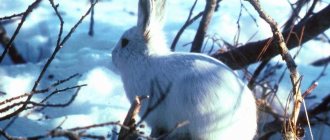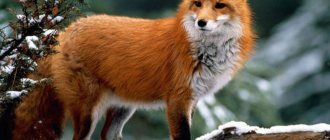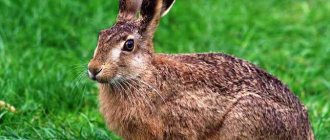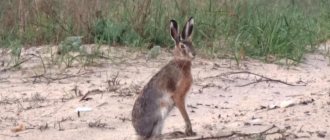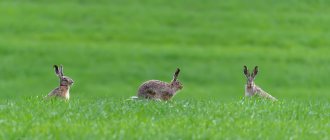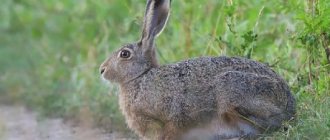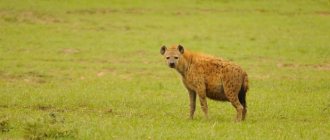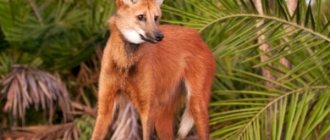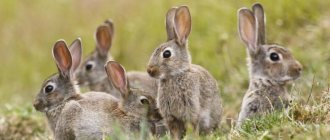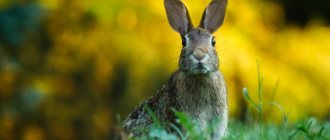The mountain hare (Lepus timidus) is famous for turning its coat white in winter. The general range of distribution of the animal is limited to the territory of the Palaearctic. By the way, this mammal is an inveterate hero of Russian folk tales.
| Latin name: | Lepus Europaeus |
| Kingdom: | Animals |
| Type: | Chordata |
| Class: | Mammals |
| Squad: | Lagomorpha |
| Family: | Zaitsevy |
| Infraclass | Placental |
| Genus: | Hares |
| Body length: | 44-65 cm |
| Weight: | 1-4 kg; average weight - 3 kg |
White hare description
Appearance
The appearance of the mountain hare depends on the environment in which it lives. For example, the length of the body including the head ranges from 43 to 61 cm. The length of the tail can be from 4 to 7 cm, and the length of the ears from 7.6 to 10.6 cm.
— Advertising —
The white hare is naturally endowed with wide paws, the feet and pads of which are covered with thick hair. Vibrissae are located on the muzzle - this is an evolutionary feature of mammals, developed in order to sense any vibrations of air in space. They look like a mustache.
These animals are characterized by bilateral symmetry. The scientific name for the phenomenon is bilateral symmetry. As we know, people are asymmetrical creatures and we are constantly told that there are no forms of life that are perfectly identical on both sides. However, there are animals that are bilaterally symmetrical. This feature is inherent in all highly organized animals, with the exception of echinoderms.
White hare coloring
— Advertising —
The color of the hare changes throughout the year of the animal in three color variants. This happens along with the photoperiod. This is the name given to the special ability of mammals, fish and insects to sense the change in day length.
- The first stage runs from June to September. The hare changes its coat to the same color - brown.
- The second stage takes place from October to January. The hare's color changes from brown to white or gray.
- The third stage takes place from February to March. The hare changes its winter color back to brown.
Interestingly, the brown color has a white ring around the eyes. The head is darker than the back, but the belly is white all year round.
Also, the white hare has three types of fur:
- undercoat about 15 mm long;
- pile hair about 25 mm long;
- protective hairs about 40 mm long.
It is worth noting that the changes in the color of the mountain hare that we notice are associated with a change in the color of the pile hair. The color of the white hare's fur can be seen in the photo attached below.
How many years do they live
The lifespan of a hare in captivity can reach 15 years or more. In nature, animals rarely survive to this age. Reproduction characteristics and a large number of natural enemies are the main reasons for premature death. In addition, hares often become hunting trophies.
Life expectancy largely depends on gender (females live longer than males) and species: the American hare can live up to 8 years, the Arctic hare - up to 6, and the black-tailed hare - up to 4-5 years.
Habitat
The mountain hare lives in most of the Palearctic. This is the name of a biogeographic region that covers the territory of Asia, Russia, all of Europe and a piece of Africa.
The species is distributed unevenly. The white hare is a typical representative of the tundra and Northern Europe. This includes Scandinavia, northern Poland, Ireland, Scotland and Wales. It is found in Mongolia, Northeast China and Japan. There are known cases of convenient acclimatization of the species in South America.
White hares are most widespread in Russia. Researchers believe that from the point of view of analyzing food preferences and climatic conditions, the central territory of the Russian Federation is most suitable for white hares. Since here coniferous forests stand in close proximity to deciduous ones and there are agricultural lands nearby.
Popular message topics
- Colosseum in ancient Rira
The construction of the Colosseum began in 71-70 BC. Emperor Vespasian. In order to find funds for the construction of the greatest structure, old taxes had to be raised and new ones introduced. - Princess Olga
Princess Olga is the only woman who was the ruler of Kievan Rus for a long time. This is a woman who went down in history as a person who strengthened the power of the state. She was not only smart, educated, but also quite cunning - Dolmens
Meanwhile, while the Egyptians were building tombs for the pharaohs, the ancient peoples of Africa, Europe, India and Korea built amazing buildings from huge fragments of stone plates - dolmens. They consist of giant platforms:
Habitat
The mountain hare species thrives in two types of habitat: tundra and forest. The Handbook of British Mammals also notes the moorlands of Ireland and Scotland. This is a biotype that is characteristic of mountainous areas and consists of heather thickets.
By themselves, snowshoe hares gravitate towards habitats that are rich in their food supply and can also provide protection. It is noted that the most uniform distribution of individuals of this species occurs in the summer, because the selected geographical areas are enriched with food and there is no snow, which prevents free movement.
Where does it live?
The distribution range of hares is all continents except Antarctica and Australia. They have adapted to live in all climatic zones: the animal can be found in the Arctic and Alaska, in the humid tropics, in mountainous regions, in arid deserts and semi-deserts.
NOBLE DEER
Where live
The hare's usual habitat is open space: in forests they prefer edges, clearings, and clearings; in the steppe zone they are found along ravines and in floodplains of rivers. In mountainous areas, hares can rise to a height of up to 2000 m above sea level.
Animals often move in search of food, and for rest they choose holes under bushes or near a fallen tree, or depressions in tall grass as shelter.
Lifestyle
Snowshoe hares prefer to live alone, but this is under favorable conditions. These are completely sedentary mammals that occupy an area of up to 30 hectares.
Movements may be caused by the search for a new favorable place with a rich food supply. Also, during the autumn-winter period, hares go into the forest and return to the lawns closer to the warm spring.
Other reasons for migration may include bad weather conditions. So, in rainy years, hares try to leave the lowlands. Or, for example, white hares living on the territory of Yakutia descend to the rivers in the fall, and rise to the mountains in the spring.
Natural enemies
Predatory animals always hunt herbivores. The main enemies of the white hare are wolves and lynxes. Owls and eagle owls also hunt them.
Cats living in forests, far from humans, often attack hares. Feral dogs gather in packs and chase hares. They hunt white hare all year round, but they still manage to survive and maintain their numbers.
The most terrible enemy of mammals is the fox.
It is especially dangerous in open areas cleared of trees and bushes, where white hares become vulnerable.
What does the hare eat?
This mammal is a vegetarian and feeds exclusively on vegetation. The diet of the white hare varies with the seasons. For example, in summer the animal eats clover, dandelions or mouse peas. This also includes grasses, yarrow, horsetail, blueberries and even some types of mushrooms.
With the arrival of autumn, the hare switches to the branches of bushes. But in winter, the animal’s diet consists mainly of tree bark or small shoots. Periodically, the winter food supply includes rowan, juniper and rose hips.
In spring, the hare comes out onto the lawns warmed by sunlight in order to taste the fresh grass. By the way, the hare does not receive enough useful minerals from the diet, so sometimes it feeds on clay.
Nutrition
The diet of the oblique is very varied. What a hare eats depends on the season, weather conditions and habitat.
In summer
In summer, this herbivorous animal eats more than 500 species of plants, preferring their green parts. Also loves to eat melons, vegetables and fruits. Animals often get out into the fields and raid vegetable gardens and orchards. In autumn, their diet includes more and more solid food. Withered grass, roots and branches of bushes become their main food.
in winter
What do hares eat in winter, when there is no greenery?
The thicker the layer of snow, the harder it is for the long-eared animal to obtain food. High snow levels can hide almost everything that hares eat in winter. Animals escape from hunger by moving closer to populated areas. They are helped out in harsh winters by haystacks, frozen berries on bushes, and fallen fruits that the animals dig out from under the snow.
Tree bark makes up the majority of the diet during the cold season. Usually the scythe selects soft trees: aspen, birch, willow and others.
in spring
In spring, the diet becomes significantly more varied due to buds, young shoots and fresh grass. To compensate for the nutritional deficiency, the long-eared eats pebbles, soil and even animal bones.
Reproduction
The mating season for snowshoe hares starts in January and ends in September. Just like color, attraction to the opposite sex and, in general, the tendency to reproduce are controlled by photoperiods.
The male's courtship is similar to stalking. He follows the female by her scent. However, the male hare has to keep his distance because if he walks too fast, the female will kick him or turn her back with her ears pricked up (a warning signal).
Whites are considered animals with great reproductive function. However, this depends on the region in which a particular individual lives. For example, in cold geographical areas such as Alaska or Chukotka, a female gives birth to only one brood per year - this happens in the summer.
On the other hand, in regions with favorable climatic conditions, the “rut” (the mating period in animals) occurs several times a year. By the way, fights often break out between males during the active breeding season.
A fertilized female bears offspring for about 47-55 days. After the start of the mating period, the first hares are born at the end of April - early May. The cubs of this brood are popularly called nastoviks.
Immediately after giving birth, female hares mate with males again and carry a brood until the end of June or even July. The third rut attracts no more than 40% of adult hares to participate, but most often the late brood dies.
The number of rabbits born directly depends on environmental conditions. As a rule, the largest brood of individuals occurs in the summer. The second criterion is the level of development of the physiology of the expectant mother and her age.
Females from warm regions give birth on the surface of the soil in a secluded place. But females from the extreme northern regions have to dig a shallow hole. It is interesting that rabbits born in these conditions are born immediately sighted and with a thick, warm fur coat.
The cub feeds on mother's milk, which is known for its high fat content. At 12 percent protein, about 15 percent fat comes out. Babies can drink such a heavy liquid only once a day. By the way, there are cases when a female hare fed other people's hares.
Life at the Zoo
At the Moscow Zoo, white hares live in a large enclosure at the “Animal World of Russia” exhibition. In addition, they are constantly kept in a group of so-called “visiting animals”, the demonstration of which accompanies lectures and conversations both in the zoo and outside it.
Hares are very good at taming (contrary to ideas about their cowardice), but they do not like loud noise. We are often asked the question of how animals get into the zoo and into the group of “exit” animals. In different ways, and here is one of those stories.
Once a visitor came to us and brought a young, absolutely tame hare. And a few days later another owner of the same hare came and said this. He picked up a half-dead, crippled little hare in a field, apparently hit by some kind of agricultural machinery. And this man turned out to be not just a good person, but also an excellent surgeon. The bunny is lucky! They put it together “piece by piece”, and the animal survived, recovered, only limping slightly on its hind leg. And he became so tame that he followed his owner everywhere like a dog. It was impossible to return him to nature, so the hare was left to live in a Moscow apartment. But the doctor’s wife turned out to be not so hare-loving and, taking advantage of her husband’s business trip, she took the hare to the zoo. The returning owner wanted to see his pet. As a rule, we do not allow former owners to visit surrendered animals, so as not to unnecessarily traumatize them. But here we made an exception. How happy they both were: both the man and the hare! We were ready to return the animal (we had not yet managed to “put it on allowance”), but the doctor decided not to risk peace in the family. The hare stayed with us. The owner visited him several more times, and the hare always recognized his savior and showed his joy in every possible way. And then the doctor decided not to “torment the soul” of either himself or the hare anymore and stopped coming. The hare quickly got used to the staff of the “on-site” group and for many years “worked” well at off-site lectures. He was never capricious and obeyed any of our trainers. But he had no other favorites except his previous owner. The range of food available to white hare in the zoo is very diverse. There are crackers, oats, peas, vegetables, hay (in winter, fresh grass in summer), and brooms (dry in winter, green in summer). Twice a week the hares receive aspen stakes with bark, and always an abundance of lick salt. Thus, the zoo strives to bring the diet as close to natural as possible. The total amount of feed consumed by the hare per day is about 2 kg. “Away” hares receive cookies or sugar as a reward for taming.
Similarities between the white hare and the brown hare
The first similarity that is worth mentioning is preferences for choosing a habitat. Both species live in forest and forest-steppe zones.
The second similarity lies in the diet of hares. These animals are completely vegetarian.
The third similarity is in physiological characteristics. Hares are endowed with powerful paws and long ears.
Interesting facts about hares
- During the winter months, you can determine where a hare is lying by looking at the tracks left in the snow. Returning from feeding to its shelter, the animal carefully confuses its tracks: it loops, makes circles, placing its paws in an already trodden path, jumps to the sides and changes the direction of movement. Tracking a white hare is a type of winter hunting that involves finding a hare's hole by unraveling the tracks left in the fresh snow. Tracking hares requires observation, patience and excellent knowledge of the animal's habits.
- Sweat glands in hares are located on the soles of their hind legs. That is why it is almost impossible to identify an animal sitting in a shelter by smell.
- The humpback hare (or agouti), which lives in Central and South America, is not actually a hare, but a rodent.
- The hare's body temperature is 38-39 degrees. During winter frosts it can drop to 37 degrees. The hare's long ears, which contain many blood vessels, help maintain a stable temperature. That is why all species living in warm climates have much longer ears than the northern representatives of the genus.
Differences between the white hare and the brown hare
- Based on the size of both species, the white hare (44-65 cm) is slightly smaller than the brown hare (57-68 cm).
- The winter color of the white hare is correlated with its name. This species is completely white except for the black tips of the ears. The brown hare turns gray.
- The white hare has fluffy fur on its paws, but the brown hare, on the contrary, has collected hair. This is why the hare's paws appear narrower.
Types of hares
Experts point out that there are at least 3 dozen species of hares in the world, which differ in size, body structure and behavior, as well as lifestyle. For example, in nature there are:
- Antelope hare.
- American snowshoe hare.
- Alaskan hare.
- Black-tailed hare.
- White-sided hare.
- Kansky hare.
- Yellowish hare.
- The hare is black and brown.
- Bush hare.
- Sandstone hare.
- Tolai hare.
- Broom hare.
- Yunnan hare.
- Korean hare.
- Corsican hare.
- Brown hare.
- Iberian hare.
- Manchurian hare.
- Curly hare.
- Stark's hare.
- White-tailed hare.
- Ethiopian hare.
- Hainan hare.
- Dark-necked hare.
- Burmese hare.
- Chinese hare.
- Yarkand hare.
- Japanese hare.
- Abyssinian hare.
Interesting moment! This list can also include the Don hare, which lived in the vastness of Eastern Europe, as well as Northern Asia during the Pleistocene period, but today is considered an extinct species. It was a fairly large representative of this genus, with a highly developed chewing system. According to scientists, the closest relative of the Don hare is the modern white hare.
Red Book
According to the analysis carried out by the researchers, the white hare is beyond the threat of extermination of the species. Therefore, this species of mammal is not listed in the Red Book.
However, there are still factors that can reduce the annual population of hares. These include epizootic, pseudotuberculosis, and tularemia. Also, helminths pose a threat, namely cestodes and nematodes, which settle in the lungs of animals.
Commercial value
Hares, despite their small size, are valuable animal species. These animals have valuable, dietary and tasty meat, as well as valuable fur, which is used for sewing warm winter clothes.
Despite the fact that hares have a sufficient number of natural enemies, they maintain their numbers thanks to their high fertility. In addition, they reproduce up to 4 times a year. These animals are distinguished by the fact that they are unpretentious either in terms of food or living conditions, therefore they quickly adapt to various living conditions. Thanks to this, hares are found in all conditions of all continents, with the exception of Antarctica.
